Abstract
This study aimed to formulation and evaluation of poly herbal toothpaste using domestic medicinal plants were collected from Butwal Sub-Metropolitan City, Nepal processed and shed dried followed by cold maceration by using distilled water. Herbal Formulation toothpaste (F1) and (F2) were prepared by using herbal extract neem, turmeric, betel, peppermint, guava and other ingredient calcium carbonate, sodium lauryl sulphate, glycerin, gum, saccharin and other preservative. The formulated herbal toothpaste is compared with marketed toothpaste they give beneficial action and safety. The observations were found to be from physical examination appearance, spread ability, pH, homogenecity, foam ability, determination of moisture and volatile matter and anti-bacterial activity. All the samples were screened for antimicrobial activity against Staphylococcus aureus (S. aureus) and Escheria coli (E. coli) bacterial strains by using the disc diffusion method along with standard drug ciprofloxacin. Experimentally it was found that by comparing the formulated and market available herbal toothpaste the value of pH ranges from (7.37 - 7.78), moisture content (11.6 - 17%), Spread ability (4.7 - 5.30 cm) foaming ability lies within (8 - 12 ml). In the antibacterial assay, the (F1) shows 14.93 ± 0.12, (F2) shows 11.9 ± 0.21 mm and market herbal toothpaste shows 19.83 ± 0.20 mm against S. aureus compare with standard ciprofloxacin 25 ± 0.29 mm zone of inhibition (ZOI). However, the extract remained insensitive against E. coli. Therefore, it may be concluded that formulated poly herbal tooth paste also has potential to exhibit anti-microbial activity and has no side effect and they prevent dental caries and dental diseases.
Keywords
Polyherbal. Formulation, Extract, ZOI, Antibacterial activity, Dental caries
Introduction
Herbal medicines are referred to the use any part of the plants for healing and treating diseases purposes. Herbal medicines have been used widely throughout human history and according to World Health Organization (WHO) about 80% of the human population used herbal medicine for primary healthcare 1. Dental caries is common in children and adolescents in the beginning because they do not practice adequate oral hygiene. Oral infections develop from the contaminated tooth's root through the jawbones and into the crevices between the fascial planes of the surrounding soft tissue. Dental plaque is a complex biofilm that forms on the surface of teeth and contains over 500 bacteria. Initial colonization of bacteria in the salivary film of enamel produces dental plaque, which is followed by subsequent colonization via antibacterial adhesion. The supporting tissues of the teeth are affected by prenominal disorders. Inadequate dental hygiene is the most common cause of gingivitis, the mildest type of prenominal illness. Gingivitis is a condition in which the gums become inflamed and bleed. Plaque that accumulates on the surface of teeth and gums is the main cause of gingivitis. Mechanical plaque control techniques are employed as a mainstay of maintaining dental hygiene2. The oral disease, and oral cavity those are problem in worldwide and therefore beneficial reduced by using herbal toothpaste and they give no side effect compare with other marketed product. Recently herbal toothpaste is increasing demand worldwide because these are less side effect and beneficial to for oral cavity and tooth decay. The other medicines are more side effect like allergies and tooth decay etc.3. Various chemical agents have been incorporated into toothpastes and mouth rinses, with some showing efficacy in reducing dental plaque formation. With increasing awareness of indigenous medical practices, there has been a growing interest in herbal medicine and alternative therapies for health care promotion. Herbal toothpastes, which donot contain synthetic agents like triclosan or fluoride, often use natural ingredients such as mineral salts (e.g. sodium fluoride and sodium chloride) and plant extracts 4. The Azadirachta indica (Neem), Mentha piperita (Peppermint), Piper betle (Betal), Psidium guajava (Guava) and Curcuma longa (Turmeric powder) are important medicinal plants for preparation many drugs and medicinal products. The drugs are obtained with whole plant of different organs like leaves, stems, barks, root, flowers, seeds, etc. The source of medicinal plants are the active chemical components involved in medicinal plants because synthetic drugs and antibiotics associated with the health hazards and toxicity associated with the increase of human diseases in order to eliminate important therapeutic help, the indiscriminate use of synthetic drugs and antibiotics 5. The major purposes of semisolid toothpaste formulations are oral cavity cleaning and oral hygiene maintenance. Today, toothpaste is seen as a basic human need because cleaning the mouth before bedtime prepares one for the day. Many commercially available toothpaste formulations are made with synthetic excipients; however, some formulations are made with herbal extracts. Some of the chemical ingredients that have been added to toothpastes and mouthwashes have been demonstrated to lessen the development of dental plaque. The use of “herbal” medicine has generated interest and aided in the establishment of complementary and alternative therapies in the field of health care promotion as a result of a greater understanding of indigenous medicinal traditions in many regions of the world. Reduced oral bacterial flora and fluoride delivery are toothpaste’s primary goals. This is because fluoride, which is naturally present in many commonplace items including food and water, has been shown to protect teeth against bacterial attack. To promote dental health, toothpaste that effectively decreases oral bacterial flora should be used. Typically, triclosan is found in gum. Because of its antibacterial qualities, it is a component used to prevent gum disease. It is also known that sodium fluoride, the active component, has antimicrobial effects 6. The major purposes of semisolid toothpaste formulations are oral cavity cleaning and oral hygiene maintenance. Today, toothpaste is seen as a basic human need because cleaning the mouth before bedtime prepares one for the day. Many commercially available toothpaste formulations are made with synthetic excipients; however, some formulations are made with herbal extracts 7. So we decided that the combination of these plant extracts may have great potential to formulate into polyherbal toothpaste since it contains a natural chemical which is safer to use compared to commercial toothpaste. Hence in the present study, we are interested in formulating different herbal paste and evaluating their physicochemical properties of polyherbal toothpaste and its antibacterial properties.
MATERIALS AND METHODS
Collection of plant material
Some leaves of Neem (Azadirachta indica), Peppermint (Mentha piperita), Betel (Piper betle) and Guava (Psidium guajava) and Turmeric powder (Curcuma longa) samples were collected from different parts of Butwal sub-metropolitan city, Nepal. The samples were well washed and stored at normal room temperature (around 25°C to 35°C) in laboratory until further use.
Table 1. Collected plant details

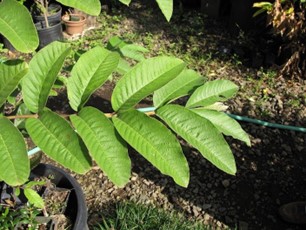
1
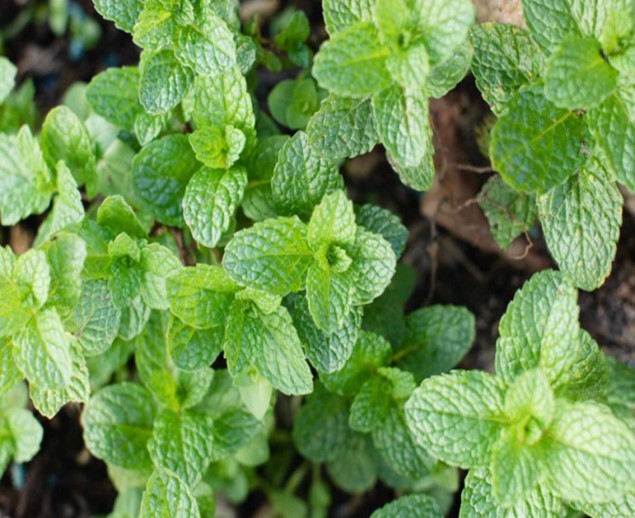
2

3

4
Figure 1: Different plant leaves: 1) Guava 2) Peppermint 3) Betel 4) Neem
Preparation of Extraction
Drying of the leaves of Neem (Azadirachta indica), Peppermint (Mentha piperita), Betel (Piper betle), Guava (Psidium guajava) Turmeric powder (Curcuma longa), and kept for shade drying at room temperature for two weeks to avoid chemical degradation due to sunlight. After 15 days, the dried sample materials were taken for crushing. Crushing of the all dried leaves of herbal ingredients was firstly done with the help of mechanical grinder and later it was firmly powered by using pestle and mortar at room temperature. The crushed sample was stored at normal room temp at chemistry laboratory. All grinned powder was dissolved in water for 72 hours. Then filtered out, the filtrate was evaporated by using water bath to get the aqueous extraction from required herbal sample. The extracts were stored in air-tight containers in the refrigerator at 4 ?C until further use.
Phytochemical Screening of aqueous extract of plant samples
The qualitative analysis of phytochemicals was done for different plant extracts with aqueous solvent by using the following standard protocols 8, 9. For all herbal ingredients i.e. Neem, Guava, Betel, Peppermint, and Turmeric powder extract different phytochemical test had been testing at the same time.
- Saponin
2 ml of sample was dissolved in 6 ml distilled water. The mixture was shaken well. Froth formation took place. Stability of the froth confirms the presence of saponin in poly herbal ingredients.
- Tannin
1 ml sample was dissolved in 1 ml 5?Cl3 solution. Appearance of dark blue colour or greenish black color confirms presence of tannin in the sample ingredients. If there are no changes in colour then heating mantle in water bath is used for changing the color.
- Flavonoids
2 gm samples were added drop wise into 20 ml NaOH. Again Conc. HCl was added drop wise, the appearance of yellow color confirms the presence of flavonoids in the sample ingredients.
- Carbohydrates
Fehling’s reagent was prepared by mixing Fehling A solution and Fehling B solution. Then Fehling A and Fehling B solution was mixed well in the ratio of 1:1 i.e. (FA+FB=10 ml). Now 1ml Fehling’s reagent was dissolved in 2 ml sample and heated for about 30 minutes. The appearance of red ppt. confirms the presence of carbohydrates in the collected poly herbal ingredients.
- Protein Test
5 ml of 1% CuSO4 was prepared and 5 ml of 5% NaOH was prepared. Mixed together. The sample was added in the solution, appearance of purple colour confirms the presence of protein in the sample ingredients
- Starch Solution
About 2 gm of sample was dissolved in 5 ml of distilled water. 2-3 drops of yellow iodine solution were added and stir well with glass road. The iodine solution will turn dark blue/black colour then starch is Present.
- Fat Test
Press the small quantity of extracts between two filters. Paper the strain on one filter indicated the presence of fixed oils.
- Terpenoid Test
2 ml sample was dissolved in 5 ml chloroform. 2ml Conc. H2SO4 was added to the solution. Reddish brown ppt. of the solution confirms presence of terpenoids in sample ingredients.
- Phenol Test
5ml extract was dissolved in distill water. 2 drops of aq. FeCl3 was added. The appearance of blue color or green color indicates presence of phenols.
- Coumarin Test
Take a look at 10% NaOH was additional to the extracts and CHCl3 was additional for observation. Yellow colour that show the presence of Coumerin.
- Quinones Test
Take a look at dilute 10% NaOH was additional to the 1ml of crude extracts. Blue-green in experienced or red coloration indicated the presence of quinones.
Formulation of Polyherbal Toothpaste
All poly herbal ingredients were dried and grounded using domestic mixer and pestle mortar. The required quantity of Ingredients was weighed and taken in mortar. Calcium carbonate, Sodium lauryl sulfate, sodium Saccharine, honey and Glycerine were mixed in certain amount of water. Acacia gum was added into the above mixture. This solution was added drop wise into mortar containing poly herbal ingredients and triturated well until a fine paste consistency is formed according to10, 11 with some modification. Table 2 shows plant extracts and composition of chemicals.
Table 2 : Chemical Composition of Formulation

Figure 2. Formulation of Herbal Toothpaste F1 and F2

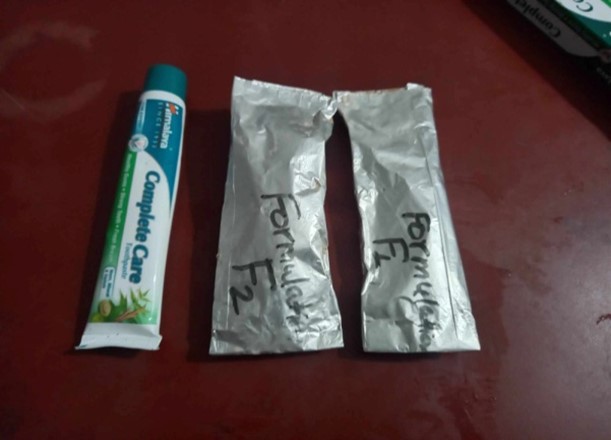
Evaluation of Toothpaste Physical Examination
Formulated toothpaste was evaluated for its color. The visually color was checked.
Odor was found by smelling the product.
Taste was checked manually by tasting the formulation.
Relative density was determining by weight in gram taken in 10 ml formulation and 10 ml distilled water using RD bottle.
Evaluation of Formulated Toothpaste
Abrasiveness 11
Extrude the content 15-20 cm long on the butter paper; repeat the same process for at least ten collapsible tubes. Press with the contents of the entire length with fingertip for the presence of sharp and hard edged abrasive particles. Toothpaste shall not contain such particles.
Determination of spread ability 11
In this method slip and drag characteristic of paste involve. The formulated paste (2 gm) placed on the ground slide under study. The formulated paste placed like sandwich between two slides for about 5 min to expel air and to provide one kg slotted weight over glass slides for uniform film of the paste between slides. Excess of the paste was scrapped off from the edges.
The spread ability can be calculated as follows:
pH determination 11
The pH value of formulated poly-herbal toothpaste was determined by using digital pH meter. 5 gm of toothpaste was mixed with 50 ml water in 100 ml of beaker. Stir vigorously to make a suspension.
Homogeneity 11
The toothpaste shall extrude a homogenous mass from the collapsible tube or any suitable container by applying of normal force at 27 ± 20?C in addition bulk of contents shall extrude from the crimp of container and then rolled it gradually.
Foaming 11
The foam ability of formulated toothpaste evaluated by taking small amount of formulation with water in measuring cylinder initial volume was noted and then shaken for 10 times. Final volume of foam was note.
Determination of froth power Foaming power = V1–V2 ………… (2)
V1- Volume in ml of foam with water.
V2- Volume in ml of water only.
Determination of Moisture and Volatile matter 12
The 5 gm of toothpaste sample have been weighed in a watch glass and heated in microwave oven at 100°C about 5 hours. The moisture content has been calculated from the difference between the initial weight and final weight.
Antibacterial Activity Test
Anti-microbial test was performed in this case to see the inhibitory effect of the Formulated and Marketed toothpaste samples according to 11 with some modification.
Growth and Maintenance for Bacteria
The strains of bacteria, organism of both gram-positive (S. aureus) and gram-negative (E. coli) were utilized. All the strains were obtained as a gift from Crimson College of Microbiology Laboratory. The strain from the plate was inoculated in the nutrient broth and then the inoculum was left for 1-2 days at 37°C in the incubator. After the growth of bacteria in the broth, it is used to perform the disc diffusion method with the given sample.
Bacteria used
• Staphylococcus aureus (S. aureus)
• Escherichia coli (E. coli)
Antibiotics
Commercially available Ciprofloxacin as standard was used.
Preparation of poly-herbal toothpaste samples
For each plant extract, 100 mg was taken accurately in a closed small tube and dissolved thoroughly in 1 mL DMSO with the help of sonication. Then, completely dissolved samples were stored in a safe place until use. Each 10 µL of sample solution contained 1 mg of plant extract.
Preparation of culture medium
Muller Hinton Agar (MHA) media preparation
38 g of MHA was placed in 1000 mL of the conical flask and, 1000mL distilled water was added. In the conical flask, the media dissolved completely and closed with a cotton plug and aluminium foil. Then the conical flask was sterilized in an autoclave at 121 ?C for 15 minutes at 15 lbs pressure for sterilization. The hot conical flask media was allowed to cool to 40-50?C in sterilized laminar airflow. The media was poured into each Petri plate and dropped to set. Two hardened media made incubated at 37?C for 24 hours to check the possible contamination, and the remaining was refrigerated at 5?C.
Preparation of nutrient broth media
13 g of nutrient broth media was suspended in 1000 mL distilled water in a 1000 mL conical flask and slightly heated to dissolve the media completely. Then it was sterilized by autoclaving at 15 lbs pressure (121?C) for 15 minutes. In a laminar airflow (LAF) hood, broth media was dispensed in about 10 ml sterilized test tube and let to chill. They got incubated at 37?C temperature for 24 hours and refrigerated.
Activation of culture plates
The media plates made previously and frozen at 5?C were incubated to dry enough. Then, the plates were cooled in a sterilized laminar airflow hood.
Preparation of bacterial suspension
Initially, nutrition broth media was prepared and sterilized. After that 5mL nutrient broth were poured into four different sterilized test tubes. Bacterial suspensions of S. aureus and E. coli were prepared to suspend bacteria (from subculture media) with the inoculating loop to each respective test tube and incubated at 37 ?C for 24 hours. The turbidity of the inoculums suspension got compared with 0.5 McFarland solutions.
Preparation of filter paper disc
Approximately 5 mm diameter of filter paper disc (from Whatman’s No. 1 filter paper) was prepared and sterilized for 15 min at 115?C.
Inoculation of bacteria into the media
A sterile cotton swab stick was dipped into the turbidity adjusted bacterial suspension. The sterile cotton swab stick was then rotated firmly inside the wall of the tube above the fluid level. This help to maintain the microbial uniformity of microorganism in the cotton swab. After that, the dried surface of the media plate was inoculated by rubbing the cotton swab stick (loaded with microorganisms) over the entire sterile media surface. This process was repeated two more times to maintain the uniform distribution of microorganisms. The same techniques were repeated for each microorganism S. aureus and E. coli. Finally, media plates were divided into four equal parts to insert the filter disc, containing sample extracts, blank control and standard antibiotic disc in equal distance. (oe, 2008)
Insertion of antibiotic disc and extract disc to the culture media
After the complete inoculation of microorganisms, antibiotic and paper disc were positioned to the petri disc, 10µL of each extract (1 mg of extract per disc) were poured to two paper disc (doublet manner) and the third paper disc was used for negative control (10 µL DMSO). All the plates were incubated at 37?C for 24 hours. All the measurements were examined in triplicate.
Measurement of ZOI
The zone of inhibition was determined. After 24 hours of incubation, the culture media was taken out from the incubator, the inhibited area (ZOI) by the different extract and antibiotics were measured in mm, with the help by Vernier caliper. The reading was taken triplicate.
Statistical Analysis
The result of antibacterial analysis was expressed as Mean ± standard deviation. The mean value was calculated using Microsoft Excel
RESULT AND DISCUSSION
Table 3. Physical evaluation
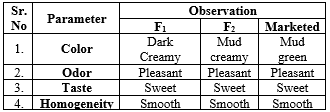
Physicochemical Analysis of Formulated and Marketed Herbal Toothpaste
Table 4. Evaluation result
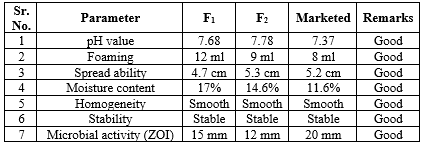
pH result
In our study all the three samples collected have been found to be slightly alkaline in nature having the pH value ranges from 7.37 to 7.78. Among these samples, Formulation (F1) have highest pH 7.78 (basic) and Formulation (F2) have 7.68 (basic) respectively while marketed Himalaya complete care toothpaste having lowest pH 7.37 (basic). The pH of the toothpaste plays an important role in keeping mouth in basic medium to prevent growing bacteria which may cause damage to our teeth such as tooth decay, cavities, and gum disease. In the previous study 13 the pH value of formulated herbal toothpaste was 7.9 and marketed herbal paste was 8.2. It signifies that the pH of our formulation were approximately identical as alkaline ranges.
Foaming ability
Among these three toothpaste samples formulation (F1) gave high foaming values as it has higher concentration of detergent in its composition than all other toothpaste samples. While marketed Himalaya complete care toothpaste gave low foaming value than all other samples analyzed as it has low concentration of detergents. The foamability of the toothpaste could assist the cleaning ability of toothpaste because the foam is expected to help remove oil, odour, food debris, microbe, and unwanted particles in the mouth 14.
Spread ability
Spread ability is a measure of how well the product can spread and penetrate different areas of following application. This study shows that the formulation (F2) gave high value of spread ability than all other toothpaste samples and formulation (F1) gave the lowest value of spread ability. Now, we can say that after viewing the data Formulation (F2) toothpaste have wide range of performance than other sample as high spread ability guarantees the high chances of wide range of performances.
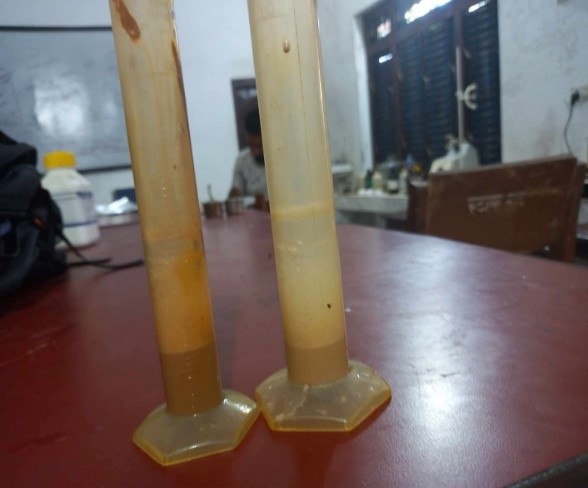
1

2
Figure 3. 1 Foaming Ability Test 2 Spread Ability Test
Moisture content
This study shows that the formulation (F2) has higher percentage of moisture than all other toothpaste samples and marketed Himalaya Complete Care toothpaste has lowest percentage of moisture. Moisture content is a measure of how much moisture i.e. water present in the samples and also determine the smoothness of the toothpaste samples. Greater the value of moisture greater will be the smoothness.

Figure 4. Overall comparison
In the previous study 11, the spread ability among the formulated herbal toothpaste was found to be 7.76 and moisture content was 15.46 %. This results shows that our study results were slightly higher in content. As compared as formulated herbal and marketed herbal toothpaste.
Phytochemical Evaluation
Table 5. Phytochemical screening of aqueous plant extracts
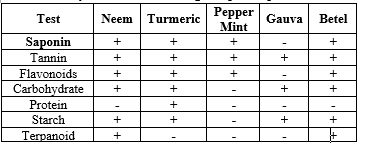
+ means Present
- means Absent
+_means Significantly present
The qualitative analysis of phytochemical screening shows that almost secondary metabolites were found in the selected plant aqueous extracts. The secondary metabolites flavonoids, phenol and tannin and saponin all were found in selected plant extracts which support the presence of phenolic, flavonoids compound as well as tannins, the phenolic compounds are mainly known to be responsible for their antiseptic, anti-inflammatory, antioxidant as well as anti-cancer properties 15.
Antibacterial Activity
The test organisms were isolated and identified and the results were recorded based on the morphological and gram stain microscopic.
Table 6. Zone of Inhibition of toothpaste samples
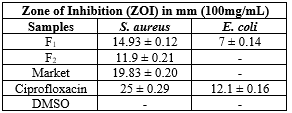
The formulated poly-herbal toothpaste samples and marketed Himalaya Complete Care toothpaste samples exhibited fairly well anti-bacterial activity against S. aureus along with standard drug ciprofloxacin. The formulation (F1) exhibited an impressive ZOI of 14.93 ± 0.12 mm and formulation (F2) exhibited 11.9 ± 0.21 mm as compare to ciprofloxacin exhibited 25 ± 0.29 mm ZOI as standard antibiotic drug. Similarly, marketed Himalaya complete care toothpaste exhibited 19.83 ± 0.20 mm ZOI. In the previous study 16 the zone of inhibition was 15 mm. Also another study 1 the ZOI of herbal toothpaste against the S. aureus strain was 19 ± 0.471, 20 ± 0.942 and 24 ± 0.816 mm at the concentration 25, 50 and 100 mg/mL respectively. It shows that, the herbal paste like our study previous study also more potent to exhibit against the S. aureus anti-microbial activity.
Figure 5. Zone of inhibition (ZOI)
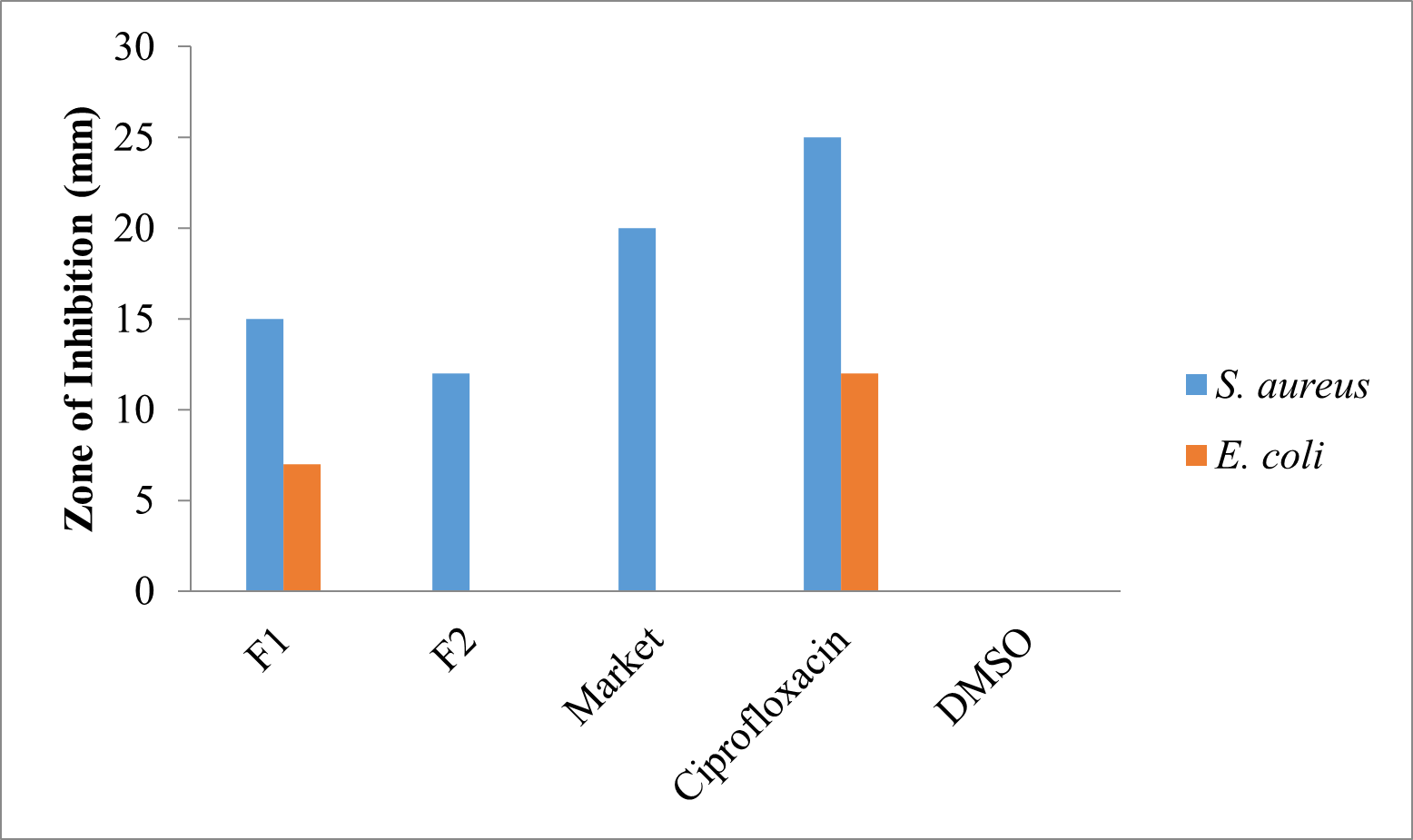


Figure 6. Zone of Inhibition (ZOI) of E. coli and S. aureus against the formulation F1, F2 and Marketed herbal toothpaste
CONCLUSION
From the above research studies, we can conclude that the results obtained in formulation of herbal tooth paste using different ingredients as plant extracts such as Neem (Azadirachta indica). Peppermint (Mentha piperita), Turmeric powder (Curcuma longa), Betel (Piper betle) and Guava (Psidium guajava) leaf extracts were good against the antibacterial activity due to presence of secondary metabolites as phytoconstituents. During our study, the quality control test for our respective optimized formulation and marketed available herbal toothpaste were observed to have pH, good physical properties, good spreadability, foamability, moisture content and antimicrobial activity was found to be well. Therefore, it may be concluded that formulated poly herbal tooth paste also has potential to exhibit anti-microbial activity. The research concluded that Herbal toothpaste is more acceptable in dental research and oral hygiene and they are safer with minimum side effect as compare to non-herbal synthetic toothpaste. The formulated toothpaste is capable for oral hygiene and show the antimicrobial activity against some chosen pathogen. The formulation compared with market Himalaya complete care toothpaste. The formulated herbal toothpaste has been good scope in future in nature remedies research and Dental health of public.
RECOMMENDATION
The present experimental data indicates inconsistency among the quality of the toothpaste. The following are the recommendation after my research work.
- The experimental procedure describes in the thesis can be used to evaluate the quality of toothpaste. The procedure can be refined to get particularly usable test analysis.
- The toothpaste companies should be more precise about the quality and content of toothpaste.
- Quality of the toothpaste and their ability should check before commercially supplying in the market.
- The all herbal toothpaste contains good pH value (slightly alkaline), good foaming ability, good spread ability and in certain range of moisture content are good for our oral hygiene.
- 5) The natural medicinal plant ingredients contain antibacterial, anti-septic, anti-oxidant properties which are essential for oral care and maintenance.
Herbal toothpaste is environment friendly, cost effective and hasn't any side effects after completion of this research project I recommended all the people to use Poly herbal toothpaste for mouthwash, better oral care and maintenance.
DATA AVAILABILITY:
The data used to support this study available from the corresponding author upon request.
CONFLICT OF INTEREST:
The authors declare that there is no conflict of interest regarding the publication in this paper.
AUTHOR CONTRIBUTIONS:
The study designed done by Sudip K and Arjun B. The manuscript was written by Arjun B. The experiments were conducted by Sudip K and Arjun B and the data were analyzed by Sudip K and Arjun B. All the authors helped with the final draft. All the authors have perused the work and given their approval.
ACKNOWLEDGEMENTS:
We are thankful to Department of Chemistry, Butwal Multiple Campus for laboratory, chemical reagent and many more support also Department of Pharmacy, Crimson College of Technology, Butwal Nepal for providing the Microbiology laboratory at antimicrobial activity analysis.
REFERENCES
- Kavita VS, Deepika K: Formulation Development and Evaluation of Herbal Toothpaste for Treatment of Oral Disease. Journal of Drug Delivery & Therapeutics. 2019; 9(4-s):98-104.
- Rajeshwari M, Maya J, Lawlesh R, Laxminarayan Y, Lokesh S, Mayank C, Dr. Jagdish CR: Formulation and Evaluation of Herbal Mouthwash. International Journal of Progressive Research in Engineering Management and Science, 2023;3(10):238-250. DOI: https://www.doi.org/10.58257/IJPREMS32154
- Akshay MA, Mohan B, Raju T, Ananta G: Formulation and comparative standardization of toothpaste. International Journal of Pharmaceutical Science and Research. 2018;3(4):12-15.
- Divyani S. Tiwaskar, Sunil S. Bhagat, Swati P. Deshmukh: Formulations and Evaluation of Herbal Toothpaste. International Journal of Multidisciplinary Research (IJMR); 2024
- Urmila N, Anupama M, Meraj A, Manoj KY, Vijay KY: Idendification test of phytochemical and antibacterial activity of using some medicinal plants. Journal of Pharmacognosy and Phytochemistry 2020; 9(2): 1551-1557.
- S. B. Nagansurkar, S. K. Bais, Snehal Deokate: Preparation and Evaluation of Herbal Toothpaste. International Journal of Advanced Research in Science, Communication and Technology; 2023;3(1): 222-233. DOI: 10.48175/IJARSCT-8094.
- Ayesha SG, Ayesha B, Aafreen F, Md. Idris G, Syeda UF: Formulation and in vitro evaluation of polyherbal antibacterial mouthwash. The Pharma Innovation Journal 2023; 12(6): 78-84.
- Alka R, Shikha K, Jitender SL, Geeta D: Qualitative Phytochemical Screening of Medicinal Plants Using Different Solvent Extracts. Oriental Journal of Chemistry; 2023;39(3):621-626. DOI : http://dx.doi.org/10.13005/ojc/390312.
- Elvino N, Moses B, Doice M, Pardon N: Extraction Methods, Quantitative and Qualitative Phytochemical Screening of Medicinal Plants for Antimicrobial Textiles: A Review. Plants; 2022;11(15): 1-17. https://doi.org/10.3390/plants11152011.
- Durgesh G, Preetam P, Kiran M, Shilpa S, Gopika S, Chinmay K, Tushar R, Dr. Vijay AJ: Preparation, Evaluation and Comparison of Herbal toothpaste with marketed Herbal toothpaste. Asian Journal of Pharmacy and Technology; 2020;10(3): 165-169. DOI: 10.5958/2231-5713.2020.00028.8.
- Urmila N, Meraj A, Anupama M: Formulation and Evaluation of a Polyherbal Toothpaste using Medicinal Plants. J. Pharm. Sci. & Res. 2020;12(1): 105-111.
- Revansiddappa M, Datta VM, Dr. Nagendra K, Vinayraj P, Shivanand K: Formulation and evaluation of herbal tooth paste by Cajanus cajan (L.) Leaf extract. Journal of Pharmacognosy and Phytochemistry 2022; 11(1): 175-178.
- Akshay MA, Mohan B, Raju T, Ananta G: Formulation and comparative standardization of toothpaste. International Journal of Pharmaceutical Science and Research. 2018;3(4):12-15.
- Olugbenga OO, Suleiman Oladokun I, Clement OO, Festus OI: Production of herbal toothpaste: Physical, organoleptic, phyto-compound, and antimicrobial properties. Heloyon, 2023;9(3): E13892. DOI::https://doi.org/10.1016/j.heliyon. 2023.e13892.
- Sipho M, Noel-David N, Andrew M, Stanley G, Mmamosheledi M, Kokoette B: Phytochemical Screening, Antioxidant and Antibacterial Properties of Extracts of Viscum continuum E. Mey. Ex Sprague, a South African Mistletoe. Plants 2022, 11(16), 2094; https://doi.org/10.3390/plants11162094.
- S. M. Shahidullah, Sumayeh B, Nishath S, Sheema S, Mohd S: Formulation and Evaluation of Herbal Toothpaste. International Journal of Research in Pharmaceutical and Nano Sciences. 2023;12(1):32-37. https://doi.org/10.36673/IJRPNS.2023.v12.i01.A05


 Arjun Bhandari* 2
Arjun Bhandari* 2


















 10.5281/zenodo.12738905
10.5281/zenodo.12738905